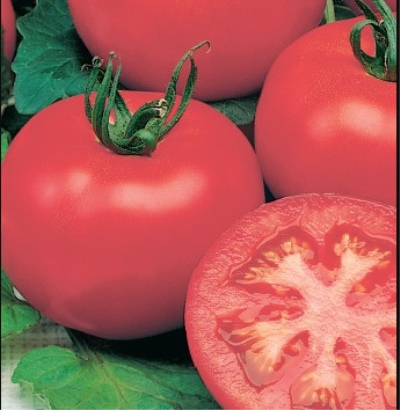
- Authors: Panchev Yu.I.
- Year of approval: 2010
- Name synonyms: Glow F1
- Category: hybrid
- Growth type: determinant
- Appointment: fresh consumption, for juice
- Ripening period: early
- Ripening time, days: 92-96
- Growing conditions: for open ground, for film greenhouses
- Marketability: high
The Zarevo tomato can be a very beneficial filling for any vegetable garden. However, reliable information is therefore particularly relevant. Only with a careful study of the variety can you count on the maximum return and successful overcoming of possible problems.
Breeding history
The developer of Zarev is the breeder Yu. I. Panchev. The main work on culture took place in the 2000s. In 2010, she received permission to grow in conventional vegetable gardens and was entered in the national register.
Description of the variety
Official synonym - Glow F1. It belongs to the number of determinantly developing hybrids. You can cultivate Zarevo both in an open garden and in a greenhouse under plastic wrap. Suppliers of planting material do not comment on the prospects for growing in glass and polycarbonate greenhouses. The height of adult bushes can reach 1-1.1 m, medium-sized green leaves will develop on them.
The main qualities of the fruit
Zarev's tomatoes, just formed from the ovaries, will have a light green color. Ripe berries turn pink. The weight of one tomato is 150 g. There are 5 or 6 such round fruits per cluster. They are characterized by smooth skin and the formation of simple inflorescences (first over 5-6 leaves, and then every one or two leaves).
Taste characteristics
Zarev's tomatoes are sweet. They develop a moderately firm flesh under the skin. Sourness and other flavors are not mentioned in the official description. The pulp is also juicy. No negative feelings are mentioned in the reviews about the harvest.
Ripening and fruiting
Fruits in the beds will ripen quite early. Between the discarding of the green growth and the full readiness of the crop for harvest, it usually takes from 92 to 96 days. But this only applies to the conditions of an ordinary year in the middle lane. In other areas - and in different weather conditions - the result may differ significantly. The period of active fruiting usually covers July, August and the first third of autumn.
Yield
Suppliers point to the possibility of receiving 2.4 kg of berries per 1 sq. m. This result may not be too impressive, but it is achieved consistently and confidently.
The timing of planting seedlings and planting in the ground
It is necessary to sow seeds in containers in March or April. Accordingly, transplantation into open land is carried out in May or June. The final choice must be made by the gardeners themselves. They will have to take into account a number of subtleties and nuances, which are impossible to predict without knowing the specific situation. In particular, it is desirable to avoid the threat of frost return.

Growing tomato seedlings is an extremely important process, because it largely depends on whether the gardener can harvest at all. All aspects must be taken into account, from seedbed preparation to planting in the ground.
Landing scheme
On the beds, the Glow tomatoes should be placed according to the 400x500 mm system. Other planting options are not suitable.

Growing and care
The stepsons will have to be removed in any case. It is also almost impossible to do without shaping the bush. Plants will definitely have to be tied up so that they are stable. Seedling bushes should be dived in the phase of 1-2 true leaves. They will have to be hardened 7-10 days before the planned transplant, otherwise rooting in an open place is not guaranteed.
It is necessary to water the bushes not so much abundantly as regularly. Only warm water should be used for this purpose. Top dressing with complex mixtures is carried out twice or three times during the growing season. It is imperative to weed the plantings. With competent agricultural technology, the fruits will form together.




A plant needs different micronutrients at each stage of growth. All fertilizers can be divided into two groups: mineral and organic. Folk remedies are often used: iodine, yeast, bird droppings, eggshells.
It is important to observe the rate and period of feeding. This also applies to folk remedies and organic fertilizers.
Disease and pest resistance
Late blight is not too dangerous for Glow. And also in the official description, resistance to fusarium wilt is declared. However, you still have to deal with at least minimal prevention, and prepare to protect yourself from infection.


Growing regions
Tomato Zarevo is certified as suitable for:
The Leningrad region and other localities of the north-west;
north of the European part of the Russian Federation;
all regions of the Urals;
The North Caucasus;
the Volga basin;
The Far East;
TsCHO;
center of the European part of the Russian Federation.

























































































